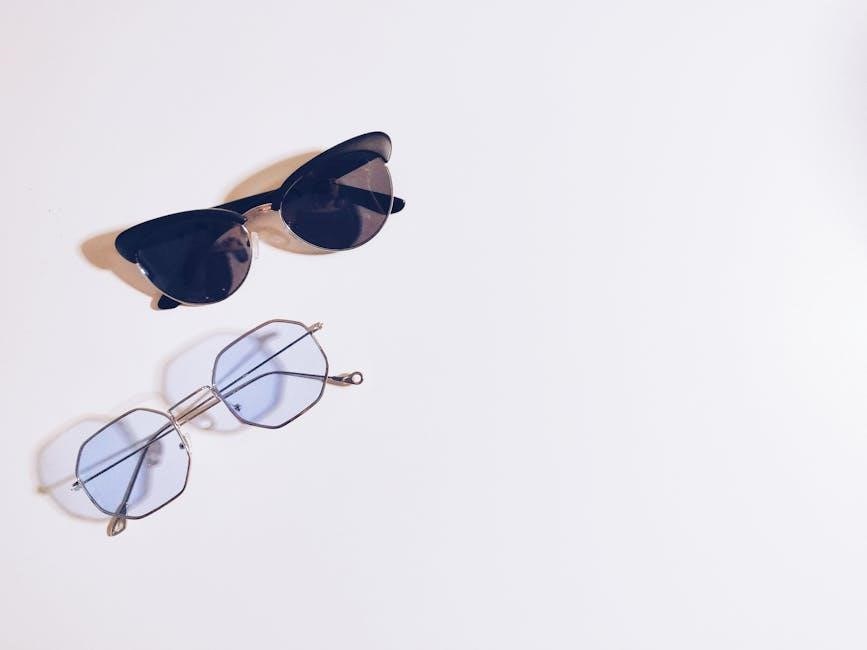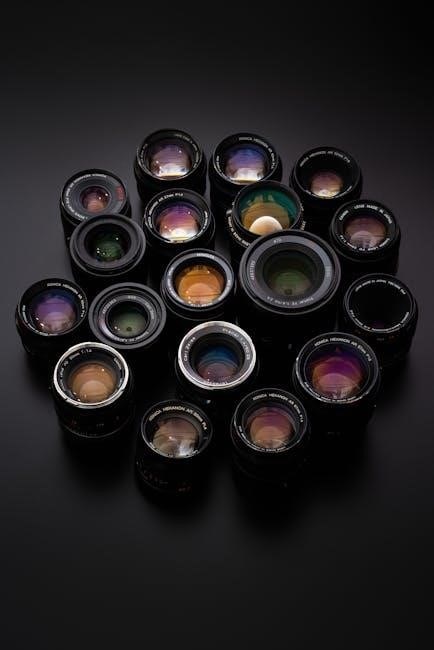Sunglass lens colors play a dual role, combining style with functionality. They protect eyes from UV rays and glare while enhancing vision clarity. Gray and green lenses are popular for everyday use, offering true color perception and reducing eye strain. Amber and yellow tints boost contrast, ideal for activities like fishing or hiking. Blue lenses add a trendy touch, while mirror and gradient options blend fashion with glare reduction. The right lens color can elevate both your look and visual comfort, making it a crucial choice in your sunglass selection.
1.1 Overview of Sunglass Lens Colors
Sunglass lens colors come in a wide range of options, each serving both functional and stylistic purposes. From classic gray and green to vibrant blue and amber, these tints enhance vision and protect eyes. Gray lenses offer true color perception, while amber and yellow enhance contrast, ideal for sports. Blue lenses add a fashionable touch, and mirror or gradient options combine style with glare reduction. The choice of lens color depends on activity, lighting, and personal style, making it a key factor in selecting the perfect sunglasses for clarity, comfort, and aesthetic appeal.
1.2 Importance of Lens Color in Sunglasses
Lens color plays a crucial role in enhancing vision, reducing eye strain, and protecting eyes from harmful UV rays. Different tints are designed to optimize visual clarity in specific environments, such as reducing glare in bright conditions or boosting contrast in low-light settings. Lens color also impacts aesthetic appeal, allowing wearers to express personal style. Additionally, certain colors improve functional performance for activities like driving or sports. Overall, lens color is a key factor in balancing comfort, protection, and style, making it essential to choose the right tint for individual needs and preferences.

History and Evolution of Sunglass Lens Colors
Sunglass lens colors trace back to ancient civilizations, with early versions like Inuit snow goggles. The 20th century saw advancements in tint technology, leading to modern, activity-specific designs;
2.1 Key Milestones in Lens Color Development
The development of sunglass lens colors began with Inuit snow goggles made from whalebone and ivory, which reduced glare. In the 20th century, UV protection became a focus, leading to tinted lenses. The 1920s introduced the first tinted sunglasses for fashion. Polarized lenses emerged in the 1930s, pioneered by Edwin Land. The 1980s saw the rise of mirror-coated lenses, while the 1990s brought photochromic lenses that adapt to light. Modern advancements include sport-specific tints and blue light blocking. Each milestone reflects evolving technology and user needs, shaping the diverse range of lens colors available today for both functionality and style.
2;2 Impact of Technology on Lens Color Innovation
Technological advancements have revolutionized sunglass lens colors, enabling enhanced functionality and style. Materials like polycarbonate and Trivex improved impact resistance while maintaining optical clarity. Anti-reflective and scratch-resistant coatings extended lens durability. Photochromic technology introduced adaptive tints that darken or lighten based on light conditions. Polarized lenses became more efficient at reducing glare. Mirror coatings, using thin-film technology, combined fashion with UV protection. These innovations have not only expanded the range of lens color options but also tailored them to specific needs, such as sports or everyday wear. Technology continues to drive customization, ensuring lenses meet both aesthetic and functional demands.

Choosing the Right Sunglass Lens Color
Selecting the perfect sunglass lens color involves balancing style, functionality, and personal preferences. Consider factors like activity type, lighting conditions, and face shape to ensure optimal comfort and aesthetics.
3.1 Factors Influencing Lens Color Selection
When choosing sunglass lens colors, consider factors like purpose, lighting conditions, face shape, and lifestyle. UV protection is essential, so ensure lenses block 99-100% of UV rays. Activity-specific needs, such as driving or sports, may require specialized tints. Face shape and skin tone also play a role in aesthetics, while personal style influences color preference. Lighting conditions, like bright sunlight or low light, affect tint darkness; Lifestyle factors, such as frequent outdoor activity or urban commuting, further guide selection. Balancing functionality and fashion ensures the right lens color enhances both vision and appearance, making it a practical and stylish choice.
3.2 Activity-Specific Lens Color Recommendations
Choosing the right lens color depends on the activity. For driving, amber or yellow lenses enhance contrast, reducing glare from headlights. Water sports benefit from polarized lenses in blue or gray, minimizing reflections on water. Hiking and outdoor activities often use gray or brown lenses for balanced vision in bright sunlight. Sports like cycling or running may prefer rose or orange tints for improved visibility. Fishing benefits from copper or amber lenses to spot underwater structures. For low-light conditions, yellow or light amber lenses enhance visibility. Each activity has specific demands, making tailored lens colors essential for optimal performance and safety. Always match the tint to the task.
3.3 Role of Lighting Conditions in Lens Color Choice
Lighting conditions play a crucial role in selecting the appropriate sunglass lens color. In bright sunlight, darker tints like gray or brown are ideal for reducing glare and minimizing eye strain. For overcast or cloudy days, lighter tints such as amber or yellow enhance contrast and improve visibility. In low-light environments, lighter-colored lenses with high transmittance, such as rose or orange, are preferred to preserve visibility without sacrificing comfort. Polarized lenses are particularly effective in reducing glare from reflective surfaces like water or snow. Adapting lens color to lighting conditions ensures optimal vision, comfort, and performance in various settings.
3.4 Personal Style and Lens Color Coordination
Personal style plays a significant role in choosing sunglass lens colors, as they should complement one’s aesthetic and preferences. For instance, cool skin tones often look best with blue, green, or purple lenses, while warm skin tones pair well with brown, amber, or gold. Hair color and wardrobe choices also influence lens color selection. Additionally, frame style and lens color should harmonize to create a cohesive look. Bold, vibrant tints like mirror or gradient lenses can add a fashionable touch, while neutral tones like gray or green offer versatility. Ultimately, lens color should reflect individuality and enhance overall style while ensuring functional benefits. Coordination between personal style and lens color ensures a polished, fashionable appearance.

Popular Sunglass Lens Colors
Popular sunglass lens colors include gray, brown, blue, amber, yellow, green, and mirror/gradient, each offering unique benefits for clarity, contrast, and style, catering to diverse preferences and needs.

4.1 Gray Lenses: Versatility and Clarity
Gray lenses are a timeless choice, offering exceptional versatility and clarity. They effectively reduce glare without distorting colors, making them ideal for bright conditions. These lenses are suitable for most face shapes and activities, providing a balanced combination of style and functionality.
Gray tints are particularly popular for driving and everyday wear, as they maintain true color perception while minimizing eye strain. Their neutral tone complements almost any frame style, making them a practical and fashionable option for users seeking a classic look with reliable performance.
4.2 Brown Lenses: Enhancing Contrast
Brown lenses are renowned for their ability to enhance contrast, making them ideal for outdoor activities like golfing, hiking, and cycling; By amplifying color differentiation, they improve depth perception and reduce eye strain, especially in bright or hazy conditions. The warm tint of brown lenses also enhances visual acuity, helping users see more clearly in natural environments.
This makes them particularly suitable for activities requiring sharp vision, such as sports or driving in mixed lighting. Additionally, brown lenses complement a wide range of frame styles, offering both functionality and a stylish appearance, making them a versatile choice for everyday use.
4.3 Blue Lenses: Aesthetic and Functional Considerations
Blue lenses are primarily chosen for their stylish and modern aesthetic, often creating a cool, calming effect. They are popular in fashion-forward sunglasses, adding a distinctive look to various frame designs. While they may not enhance contrast as much as other colors, blue lenses can reduce glare from reflective surfaces like water or snow, making them suitable for water sports or skiing.
However, blue lenses might slightly alter color perception, which could be less ideal for tasks requiring precise color accuracy. Despite this, their trendy appeal and ability to reduce eye strain in bright environments make them a popular choice for casual, fashion-focused wearers.
4.4 Amber and Yellow Lenses: High Contrast Options
Amber and yellow lenses are designed to enhance contrast, making them ideal for low-light conditions and activities like hunting, cycling, or hiking. These tints reduce blue light, which can improve vision in hazy or foggy environments. Amber lenses are particularly popular among shooters and drivers, as they heighten clarity and reduce glare. Yellow lenses, on the other hand, are often preferred by athletes, as they can improve reaction time by brightening surroundings. Both options are excellent for individuals seeking better visibility without sacrificing style, making them versatile choices for both functional and aesthetic purposes.
4.5 Green Lenses: Natural Vision and Style
Green lenses offer a unique blend of natural vision and timeless style, making them a popular choice for sunglasses. They reduce eye strain by minimizing color distortion, providing sharp, true-to-life visuals. Green tints are ideal for everyday wear, as they enhance contrast without altering color perception significantly. Their subtle, earthy tone complements a wide range of frame styles, from classic aviators to modern designs. Whether for casual outings or active lifestyles, green lenses strike a balance between functionality and fashion, offering a sophisticated look while maintaining exceptional optical clarity and comfort in various lighting conditions.
4.6 Mirror and Gradient Lenses: Fashion Meets Function
Mirror and gradient lenses combine style with practicality, offering a trendy aesthetic while enhancing visual performance. Mirror lenses feature a reflective coating that reduces glare and adds a sleek, modern look. Available in various colors like silver, gold, and blue, they complement diverse fashion tastes. Gradient lenses transition from dark to light, providing shade at the top and clearer vision at the bottom, ideal for activities like driving. Both styles are versatile, blending seamlessly with casual or sporty frames. Whether for fashion statements or functional benefits, mirror and gradient lenses deliver a perfect mix of trendiness and optical precision for everyday wear.

Specialized Sunglass Lens Colors
Specialized sunglass lens colors are tailored for unique requirements, enhancing performance and style for specific activities or conditions, ensuring optimal vision and aesthetic appeal in diverse settings.
5.1 Polarized Lenses: Reducing Glare
Polarized lenses are designed to minimize glare from reflective surfaces like water, snow, and car windshields by blocking horizontally polarized light. This technology enhances visual clarity, reduces eye strain, and improves safety during activities such as driving or fishing. Polarized sunglasses are particularly beneficial in bright environments, offering superior comfort and sharper vision. However, they may not always be suitable for digital screens, as they can cause visibility issues with certain displays. Overall, polarized lenses are a practical choice for outdoor enthusiasts seeking to combat glare effectively while maintaining style and functionality.
5.2 Photochromic Lenses: Adaptive Tint Technology
Photochromic lenses offer adaptive tint technology that automatically adjusts to changing light conditions, providing optimal vision in various environments. In bright sunlight, these lenses darken to reduce glare and UV exposure, while in low-light conditions, they lighten to improve visibility. This technology eliminates the need to switch between multiple pairs of sunglasses, offering unmatched convenience. The tint change is triggered by UV rays, with the molecules in the lens altering their structure to block more or less light. While the transition takes a few seconds, photochromic lenses are ideal for everyday use, ensuring comfort and clarity across diverse lighting scenarios.
5.3 Tints for Specific Sports and Activities
Specific sports and activities benefit from tailored lens tints that enhance performance and visibility. For cycling, yellow or orange tints improve contrast and reduce eye strain. Skiers and snowboarders prefer dark gray or black lenses to combat intense snow glare. Water sports enthusiasts opt for polarized blue or green tints to reduce reflections on water. Golfers often choose amber or copper tints to enhance green tones and improve ball tracking. Runners and hikers may prefer light-enhancing tints like yellow or rose for low-light conditions. Each activity demands a unique tint to optimize vision, ensuring safety and peak performance in specialized environments.

Impact of Lens Color on Vision
Lens color significantly affects visual clarity, contrast, and glare reduction, enhancing overall vision quality. Different tints optimize vision for specific conditions, improving safety and comfort in various lighting environments;
6.1 Color Perception and Lens Tint
Sunglass lens tints alter color perception by filtering specific wavelengths of light. Gray lenses maintain true color accuracy, while brown and amber tints enhance warmth and contrast. Blue and green tints can slightly distort colors but offer unique aesthetic benefits. Yellow lenses heighten brightness and clarity, making them ideal for low-light conditions. The tint’s intensity and hue affect how colors are perceived, impacting visual sharpness and vibrancy. Understanding these effects helps users choose tints that align with their activities and preferences, ensuring optimal vision without compromising style or functionality.
6.2 Contrast Enhancement for Better Clarity
Contrast enhancement is a key benefit of sunglass lens tints, improving visual clarity in various lighting conditions. Certain tints, such as amber and yellow, accentuate differences between colors and objects, making them stand out more clearly. This is particularly useful for activities like golf, cycling, or hiking, where seeing subtle details is essential. Brown lenses also enhance contrast by deepening warm tones, reducing eye strain in bright environments. By optimizing contrast, these tints improve visual acuity, helping users navigate or perform tasks with greater precision and comfort. Enhanced contrast ensures a sharper, more defined view of the world around you.
6.3 Glare Reduction and UV Protection
Glare reduction and UV protection are critical functions of sunglass lens colors. Polarized lenses are especially effective at minimizing glare from reflective surfaces like water, snow, or car windshields by blocking horizontally polarized light waves. This enhances comfort and reduces eye strain. Additionally, UV protection is essential for safeguarding eye health, as prolonged exposure to harmful ultraviolet rays can lead to conditions like cataracts or macular degeneration. Many lens tints, such as gray and brown, inherently block UV radiation, while others may require specialized coatings. Combining glare reduction with UV protection ensures optimal eye safety and visual comfort in bright environments.

Combining Lens Colors with Frame Styles
Sunglass lens colors should complement frame styles. Classic frames pair well with neutral tones, while bold frames enhance vibrant lens colors for a stylish, cohesive look.
7.1 Matching Frames with Lens Colors
Matching frames with lens colors enhances both style and functionality. Neutral frame colors like black, brown, or silver pair well with versatile lens tints such as gray, green, or blue. Brightly colored frames, like red or yellow, are best complemented by contrasting lens colors to avoid clashing. Metallic frames often look sleek with mirror or gradient lenses, while wooden or acetate frames suit earthy tones like amber or brown. Consider face shape and personal style to ensure a cohesive look. For instance, oversized frames with dark lenses create a chic vibe, while slim frames with light tints offer a minimalist appeal. Balance is key to a polished appearance.
7.2 Face Shape Considerations for Lens Color
Face shape plays a significant role in selecting the ideal lens color. Oval faces are versatile and can suit most lens colors, but cooler tones like blue or green can enhance natural features. Round faces benefit from angular frames with contrasting lens colors, such as dark gray or black, to create elongation. Square faces look best with softer lens colors like amber or brown to balance sharp angles. Heart-shaped faces can opt for lighter-colored lenses at the bottom to draw attention downward. Consider your face shape to ensure the lens color complements your proportions and enhances your overall style. Balance is key for a flattering look.

Outdoor Activities and Lens Colors
Sunglass lens colors play a crucial role in enhancing visual performance during outdoor activities. Whether driving, fishing, or hiking, the right tint improves clarity and reduces glare for optimal vision.
8.1 Best Lens Colors for Driving
When it comes to driving, choosing the right sunglass lens color is crucial for safety and visibility. Gray lenses are a popular choice as they provide neutral color perception and reduce glare without distorting colors. Amber or yellow lenses are also excellent, especially in low-light conditions, as they enhance contrast and improve visibility of road surfaces. Blue lenses, while stylish, may not be ideal for driving due to potential glare from reflected light. For optimal clarity, consider polarized lenses, which minimize glare from windshields or the road, enhancing overall driving comfort and safety.
8.2 Lens Colors for Water Sports and Fishing
When engaging in water sports or fishing, the right lens color can enhance visibility and reduce glare from water surfaces. Polarized lenses are ideal as they minimize reflections from the water, improving clarity and reducing eye strain. For fishing, copper or amber lenses are recommended because they enhance contrast, helping anglers spot fish and underwater structures more easily. Gray lenses are versatile and work well in bright sunlight, while mirror coatings can add extra glare protection. Consider blue or green mirrors for a stylish option that still provides functional benefits. Always opt for lenses with UV protection to safeguard your eyes in reflective environments.
8.3 Hiking and Outdoor Adventures: Optimal Lens Colors
For hiking and outdoor adventures, choosing the right lens color is crucial for clarity and protection. Neutral shades like gray or green are excellent for bright, sunny conditions, as they maintain natural color perception while reducing glare. Brown lenses enhance contrast, making them ideal for uneven terrain. Amber or yellow lenses are beneficial in low-light conditions, such as early morning or late afternoon, by improving visibility. Polarized lenses are highly recommended to reduce glare from reflective surfaces like water or snow. Opt for UV-protective coatings to safeguard your eyes at high altitudes. The right lens color ensures a safer and more enjoyable outdoor experience.
Technology Behind Sunglass Lens Colors
Advanced materials like polycarbonate and Trivex enhance durability and optical clarity. Coatings such as anti-reflective and scratch-resistant improve functionality. Innovations in tint technology, including photochromic and mirror coatings, optimize performance.
9.1 Materials and Coatings in Lens Colors
Sunglass lens colors are influenced by the materials and coatings used in their construction. Polycarbonate and Trivex lenses are lightweight and impact-resistant, often featuring tinted coatings for enhanced color perception. Glass lenses offer superior optical clarity but are heavier. Acrylic lenses are cost-effective and versatile, commonly used for fashion-forward designs. Coatings like anti-reflective, hydrophobic, and scratch-resistant layers enhance durability and functionality. Mirror coatings combine style with glare reduction, while UV-blocking treatments ensure eye protection. The choice of material and coating determines the lens’s performance, durability, and aesthetic appeal, making them critical factors in achieving desired lens colors for various purposes.
9.2 Innovations in Tint Technology
Recent advancements in tint technology have revolutionized sunglass lens colors, offering enhanced functionality and style. Photochromic lenses now adapt faster to changing light conditions, providing optimal tint adjustment. Anti-reflective coatings reduce glare from screens and surfaces, while nano-ceramic tints offer superior scratch resistance. Another innovation is the integration of polarized technology into mirrored lenses, combining fashion with glare reduction. Additionally, eco-friendly tints made from plant-based dyes are emerging, catering to sustainability-conscious consumers. These innovations ensure that sunglass lenses not only improve vision but also align with modern lifestyle demands, blending performance, durability, and aesthetic appeal seamlessly.

Buying Guide for Sunglass Lens Colors
Choosing the right lens color involves considering UV protection, lens material, and personal style. Evaluate activities, face shape, and lighting conditions to make an informed decision. Prioritize functionality while ensuring the color complements your frame and lifestyle for optimal vision and aesthetic appeal.
10.1 Steps to Select the Right Lens Color
When choosing the perfect lens color, start by assessing your primary use case—whether it’s for daily wear, sports, or specific outdoor activities. Consider the lighting conditions you’ll most often encounter, as this impacts clarity and comfort. Reflect on your personal style to ensure the color complements your preferences. Test how different tints affect your vision by trying them in real conditions if possible. Finally, consider your face shape and skin tone to ensure a harmonious match. By evaluating these factors, you can narrow down options and select a lens color that balances functionality, aesthetics, and personal comfort. This ensures optimal vision and style.
10.2 Prescription Sunglasses: Lens Color Options
Prescription sunglasses offer a wide range of lens color options to suit individual needs. Whether you prefer classic gray, brown, or blue lenses, prescription sunglasses can be tailored to match your style and vision requirements. Many opt for amber or yellow lenses for enhanced contrast, while others choose green for natural color perception. Specialized options like polarized or photochromic lenses are also available, providing glare reduction and adaptive tint technology. UV protection and anti-reflective coatings can be added to further enhance functionality. With advancements in lens technology, prescription sunglasses now offer a seamless blend of fashion and functionality, ensuring clear vision and style for every wearer.
10.3 Maintenance and Care of Colored Lenses
Proper maintenance ensures colored lenses retain their vibrancy and functionality. Use a soft, microfiber cloth to clean lenses, avoiding harsh chemicals or abrasive materials that can scratch the surface. Avoid exposing sunglasses to extreme temperatures, as this may cause warping or discoloration. Store them in a protective case when not in use to prevent damage. Regularly inspect lenses for scratches or fading, and replace them if necessary. For prescription lenses, follow the manufacturer’s cleaning instructions to maintain optical clarity. Proper care extends the lifespan of your sunglasses and preserves the aesthetic appeal of their colored lenses.
11.1 Summary of Key Considerations
When selecting sunglass lens colors, prioritize purpose, lighting conditions, and personal style. Different colors enhance contrast, reduce glare, or improve visibility in specific environments. Gray lenses offer neutrality, while brown and amber enhance contrast, making them ideal for driving or sports. Blue and mirror lenses are more fashion-forward, while green provides natural vision. Consider face shape and frame style to ensure a flattering combination. Activity-specific tints, like polarized for water or photochromic for changing light, can optimize performance. Ultimately, balance aesthetics with functionality to choose lenses that enhance vision, protect eyes, and complement your lifestyle. Personal preferences should guide your final decision.
11.2 Final Thoughts on Choosing the Perfect Lens Color
Choosing the perfect sunglass lens color is a balance of personal style, functionality, and environmental factors. Consider your lifestyle, whether you’re driving, hiking, or lounging by the water, as different activities demand specific tints. Think about lighting conditions—bright days may call for darker shades, while overcast skies might benefit from lighter options. Don’t forget to align your choice with your face shape and frame style for a cohesive look. Ultimately, prioritize lens quality, UV protection, and features like polarization or photochromic technology to enhance both vision and comfort. Your ideal lens color is where fashion meets functionality seamlessly.

